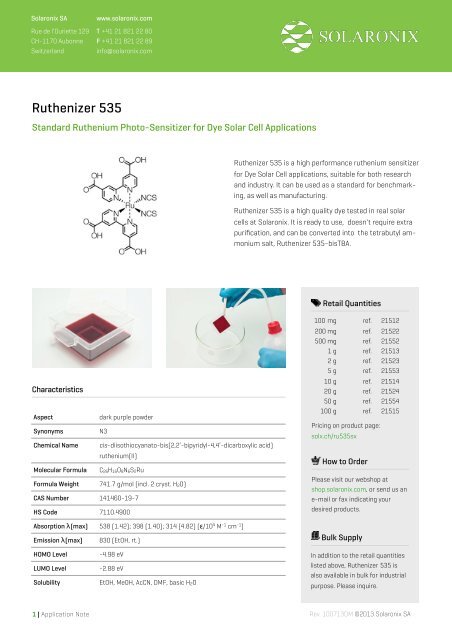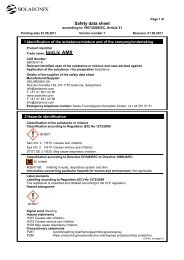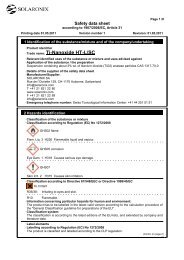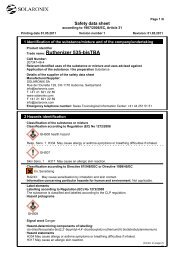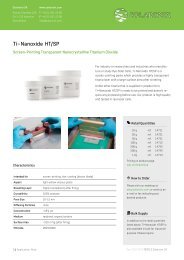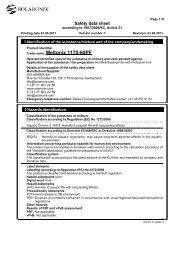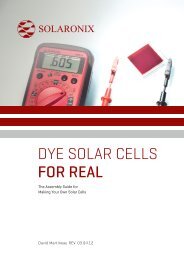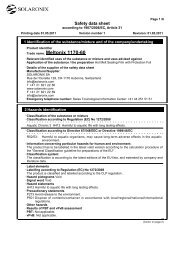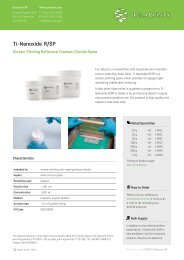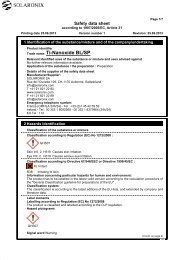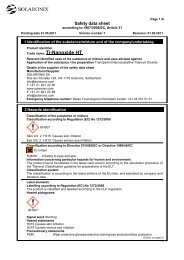Note Ruthenizer 535 - Solaronix
Note Ruthenizer 535 - Solaronix
Note Ruthenizer 535 - Solaronix
Create successful ePaper yourself
Turn your PDF publications into a flip-book with our unique Google optimized e-Paper software.
<strong>Solaronix</strong> SA<br />
www.solaronix.com<br />
<strong>Ruthenizer</strong> <strong>535</strong> | Application <strong>Note</strong><br />
Rue de l’Ouriette 129 T +41 21 821 22 80<br />
CH-1170 Aubonne F +41 21 821 22 89<br />
Switzerland<br />
info@solaronix.com<br />
<strong>Ruthenizer</strong> <strong>535</strong><br />
Standard Ruthenium Photo-Sensitizer for Dye Solar Cell Applications<br />
<strong>Ruthenizer</strong> <strong>535</strong> is a high performance ruthenium sensitizer<br />
for Dye Solar Cell applications, suitable for both research<br />
and industry. It can be used as a standard for benchmarking,<br />
as well as manufacturing.<br />
<strong>Ruthenizer</strong> <strong>535</strong> is a high quality dye tested in real solar<br />
cells at <strong>Solaronix</strong>. It is ready to use, doesn't require extra<br />
purification, and can be converted into the tetrabutyl ammonium<br />
salt, <strong>Ruthenizer</strong> <strong>535</strong>-bisTBA.<br />
Retail Quantities<br />
Characteristics<br />
Aspect<br />
dark purple powder<br />
Synonyms<br />
N3<br />
Chemical Name cis-diisothiocyanato-bis(2,2’-bipyridyl-4,4’-dicarboxylic acid)<br />
ruthenium(II)<br />
Molecular Formula C 26H 16O 8N 6S 2Ru<br />
Formula Weight 741.7 g/mol (incl. 2 cryst. H 2O)<br />
CAS Number 141460-19-7<br />
HS Code 7110.4900<br />
Absorption λ(max) 538 (1.42); 398 (1.40); 314 (4.82) (ε/10 4 M -1 cm -1 )<br />
Emission λ(max) 830 (EtOH, rt.)<br />
100 mg ref. 21512<br />
200 mg ref. 21522<br />
500 mg ref. 21552<br />
1 g ref. 21513<br />
2 g ref. 21523<br />
5 g ref. 21553<br />
10 g ref. 21514<br />
20 g ref. 21524<br />
50 g ref. 21554<br />
100 g ref. 21515<br />
Pricing on product page:<br />
solx.ch/ru<strong>535</strong>sx<br />
How to Order<br />
Please visit our webshop at<br />
shop.solaronix.com, or send us an<br />
e-mail or fax indicating your<br />
desired products.<br />
Bulk Supply<br />
HOMO Level<br />
LUMO Level<br />
Solubility<br />
-4.98 eV<br />
-2.88 eV<br />
EtOH, MeOH, AcCN, DMF, basic H 2O<br />
In addition to the retail quantities<br />
listed above, <strong>Ruthenizer</strong> <strong>535</strong> is<br />
also available in bulk for industrial<br />
purpose. Please inquire.<br />
1 | Application <strong>Note</strong> Rev. 100713DM ©2013 www.solaronix.com<br />
<strong>Solaronix</strong> SA
<strong>Ruthenizer</strong> <strong>535</strong> | Application <strong>Note</strong><br />
USAGE<br />
<strong>Ruthenizer</strong> <strong>535</strong> is known to very efficiently photo-sensitize<br />
titanium dioxide (titania) in the visible spectrum up to a<br />
wavelength of ~750 nm. This compound is commonly referred<br />
as N3 in the literature. It is so far one of the best<br />
pigments for Dye Solar Cells, and is considered an industry<br />
standard.<br />
<strong>Ruthenizer</strong> <strong>535</strong> is used to prepare staining solutions in<br />
which metal-oxide semi-conductor electrodes will be immersed.<br />
The dye naturally adsorbs on the semi-conductor<br />
surface, resulting in a colored electrode bearing a sensitizing<br />
layer of dye molecules.<br />
Staining Procedure For Titania Electrodes<br />
Weigh the amount of dry powder necessary to make a<br />
0.5 mM ethanol solution of the required volume. Make sure<br />
the volume is sufficient to completely immerse the electrode(s).<br />
The addition of chenodeoxycholic acid (10 fold) in the staining<br />
solution yields a significant performance boost.<br />
Place the dye powder in a sealable container and add the<br />
required volume of ethanol. Absolute ethanol is good, but<br />
not strictly necessary. Alternatively, methanol can be used<br />
with this dye.<br />
Stir the mixture in a sealed vessel at room temperature<br />
(e.g. a glass bottle with stir bar). The solution rapidly turns<br />
dark purple although most of the solid is yet to be dissolved.<br />
Coarse grains can take a while to dissolve so prolong<br />
stirring until no traces of solid are visible.<br />
If necessary, briefly sonicate the solution to help dissolution.<br />
Beware that excessive sonication is potentially harmful to the<br />
dye molecules.<br />
Position the titania electrodes in a flat-bottomed, sealable<br />
container, side by side, with titania layers facing up. This is<br />
important in order to prevent scratching the fragile titania<br />
surface.<br />
Pour a freshly prepared dye solution into the container and<br />
fully immerse the electrodes. Too little liquid won't allow the<br />
titania surface to adsorb enough dye and the electrodes<br />
may appear unevenly colored.<br />
For best results fire the titania electrodes just before staining<br />
so they don't pick up ambient moisture. It is best to put them<br />
in the staining bath while still warm, 50-60°C. Such mesoporous<br />
titania electrodes are easily polluted by volatile substances.<br />
Seal the container with a lid and wait for the titania surface<br />
to get entirely stained. This takes several hours and can be<br />
conveniently left overnight. Make sure to avoid excessive<br />
light exposure during the staining process. Dye molecules<br />
are very light sensitive in solution, and even more so when<br />
adsorbed on titania and dry.<br />
Remove the stained electrodes with plastic tweezers (to<br />
avoid metal traces pollution). Rinse thoroughly with ethanol<br />
to remove any excess dye which could otherwise cause a<br />
detrimental build up of dye molecules. Discard the rinsing<br />
waste.<br />
Staining solutions can be reused several times, provided the<br />
concentration is sufficient. However, dye solutions are not<br />
suitable for long term storage. Dye oxidation and precipitation<br />
may occur over time. It is preferable to store the dried<br />
dye powder in its original container and prepare solutions<br />
when needed.<br />
Completely dry the electrodes with an inert gas flow or with<br />
a brief gust from a hair-drier held at a reasonable distance.<br />
Make sure to assemble the solar cells immediately. Stained<br />
electrodes are fragile, keep them in a sealed environment<br />
away from light until you are ready for assembly.<br />
A properly stained titania electrode should look quite dark<br />
(especially if opaque) and purple. A brownish color indicates<br />
the dye has degraded and will result in poor cell performance.<br />
Common Pitfalls<br />
A white or faded coloration indicates poor staining, the entire<br />
surface of the electrode visibly didn't get colored. Try to<br />
increase the dye concentration or lengthen the staining<br />
time. If the problem persists, use recommend staining<br />
conditions for troubleshooting, change solvent, or check for<br />
moisture in the solution.<br />
It could also indicate the structure of the titania electrode<br />
is not porous enough. Investigate possible titania issues<br />
such as firing process, poor porosity, or large particle size.<br />
A brownish stained electrode indicates the dye has been<br />
oxidized, it's no longer purple. Discard the staining solution<br />
for a fresh one if it has changed color. Also, avoid exposing<br />
2 | Application <strong>Note</strong> www.solaronix.com
<strong>Ruthenizer</strong> <strong>535</strong> | Application <strong>Note</strong><br />
freshly stained electrodes to ambient atmosphere or moisture<br />
for too long, dye molecules adsorbed on the titania<br />
can be easily oxidized, especially when exposed to light.<br />
7<br />
6<br />
5<br />
Current<br />
Power<br />
7<br />
6<br />
5<br />
Staining the electrodes for too long can also lead to reduced<br />
solar cell performance because of dye molecule aggregation.<br />
Consider using a lower dye concentration, or<br />
shortening the staining time if possible.<br />
Current (mA)<br />
4<br />
3<br />
2<br />
1<br />
4<br />
3<br />
2<br />
1<br />
Power (mW)<br />
Deprotonated Analogue: <strong>Ruthenizer</strong> <strong>535</strong>-bisTBA<br />
<strong>Ruthenizer</strong> <strong>535</strong> exists in a doubly deprotonated form,<br />
named <strong>Ruthenizer</strong> <strong>535</strong>-bisTBA, which allows for higher<br />
photovoltaic performances (eg. higher V oc). <strong>Ruthenizer</strong><br />
<strong>535</strong>-bisTBA is notably more soluble than <strong>Ruthenizer</strong><br />
<strong>535</strong>, making it easier to work with concentrated staining<br />
solutions. See solx.ch/ru<strong>535</strong>tba for more information.<br />
0<br />
0<br />
0 0.1 0.2 0.3 0.4 0.5 0.6 0.7 0.8<br />
Voltage (V)<br />
V oc<br />
704 mV<br />
J sc 16.22 mA/cm 2<br />
FF 0.65<br />
Eff. 7.4 %<br />
EXAMPLE<br />
A Dye Solar Cell Sensitized with <strong>Ruthenizer</strong> <strong>535</strong><br />
A 36 mm 2 titania photo-anode was prepared with 4 printed<br />
layers of Ti-Nanoxide T/SP and 1 printed layer of Ti-<br />
Nanoxide R/SP on a TCO22-7 glass substrate. The electrode<br />
was stained in a solution of <strong>Ruthenizer</strong> <strong>535</strong> using the<br />
procedure described above with chenodeoxycholic acid<br />
(1:10) as a co-adsorbent. A platinum coated cathode was<br />
prepared on another TCO22-7 substrate with a layer of<br />
Platisol T. The two electrodes were laminated together using<br />
Meltonix 1170-60, and the solar cell was filled with Iodolyte<br />
AN-50 through a hole in the cathode. The filling hole<br />
was then sealed with Meltonix 1170-60 and a thin glass<br />
circle of 6 mm diameter.<br />
The resulting solar cell was placed under 1 sun illumination<br />
using a calibrated <strong>Solaronix</strong> Solixon Class-A solar simulator<br />
and equipped with an adequate mask to avoid overillumination,<br />
yielding the following current-voltage curve<br />
and tabulated results.<br />
STORAGE AND SAFETY<br />
Storage<br />
Store the product in its original container, upright and tightly<br />
sealed. Keep in a dry place at room temperature, and away from<br />
light.<br />
The product is not known to suffer from degradation when stored<br />
properly. Consider filling the container with inert gas for very long<br />
term storage.<br />
While in use, avoid leaving the container open unnecessarily.<br />
Safety<br />
<strong>Ruthenizer</strong> <strong>535</strong> is for research and development use only and is<br />
intended to be manipulated by knowledgeable personnel. Ensure<br />
good ventilation of the workplace, and wear suitable protective<br />
equipment.<br />
Signal word: Warning<br />
For a complete description of safety measures, please refer to the Material<br />
Safety Datasheet (MSDS) of <strong>Ruthenizer</strong> <strong>535</strong>.<br />
solaronix.com/msds/<br />
3 | Application <strong>Note</strong> www.solaronix.com
<strong>Ruthenizer</strong> <strong>535</strong> | Application <strong>Note</strong><br />
RELATED PRODUCTS<br />
Cited in This Document<br />
- Chenodeoxycholic Acid, staining additive.<br />
- TCO22-7, FTO coated glass substrates.<br />
- Ti-Nanoxide T/SP, screen-printable titania nanoparticles paste.<br />
- Ti Nanoxide R/SP, screen-printable reflective titania paste.<br />
- Platisol T, platinum precursor paint.<br />
- Iodolyte AN-50, high efficiency electrolyte.<br />
- Meltonix 1170-60, hot-melt sealing films.<br />
- Solixon, continuous illumination solar simulators.<br />
Consider Also<br />
- <strong>Ruthenizer</strong> <strong>535</strong>-bisTBA, higher performing analogue.<br />
- <strong>Ruthenizer</strong> 620-1H3TBA, panchromatic ruthenium dye.<br />
- <strong>Ruthenizer</strong> 520-DN, amphiphilic ruthenium dye.<br />
REFERENCES<br />
Articles About N3<br />
For further reading, have a look at the following articles:<br />
- J. Am. Chem. Soc. 1993, 115, 6382-6390<br />
[doi:10.1021/ja00067a063]<br />
- Adv. Mater. 1997, 9, 904-906<br />
[doi:10.1002_adma.19970091111]<br />
- Chem. Mater. 1998, 10, 2533-2541<br />
[doi:10.1021_cm980303g]<br />
- Inorg. Chem. 1999, 38, 3836-3846<br />
[doi:10.1021_ic990344u]<br />
- Inorg. Chem. 1999, 38, 6298-6305<br />
[doi:10.1021_ic990916a]<br />
- Acc. Chem. Res. 2000, 33, 269-277<br />
[doi:10.1021_ar980112j]<br />
- Thermochimica Acta 2000, 348, 105-114<br />
[doi:10.1016_S0040-6031(99)00486-4]<br />
- J. Phys. Chem. B 2001, 105 (29), 6867–6873<br />
[doi:10.1021/jp004411d]<br />
- J. Am. Chem. Soc. 2002, 124, 489-493<br />
[doi:10.1021_ja016561n]<br />
- J. Phys. Chem. B 2002, 106, 3926-3932<br />
[doi:10.1021_jp014343a]<br />
- J. Photochem. Photobiol. A. Chemistry 2004, 164, 3–14<br />
[doi:10.1016_j.jphotochem.2004.02.023]<br />
- Inorganica Chimica Acta 2009, 362, 5155-5162<br />
[doi:10.1016_j.ica.2009.09.001]<br />
People Using <strong>Ruthenizer</strong> <strong>535</strong><br />
A selection of publications using <strong>Ruthenizer</strong> <strong>535</strong>:<br />
- Applied Physics Letters 2005, 87, 113113<br />
[doi:10.1063/1.2048816]<br />
- Solar Energy 2005, 79, 422–430<br />
[doi:10.1016/j.solener.2005.02.017]<br />
- J. Phys. Chem. C 2008, 112, 19151–19157<br />
[doi:10.1021/jp806281r]<br />
- Electrochimica Acta 2009, 54, 4123–4130<br />
[doi:10.1016/j.electacta.2009.02.052]<br />
- Energy Environ. Sci., 2010, 3, 838–845<br />
[doi:10.1039/b921360k]<br />
- J. Phys. Chem. C 2010, 114, 8398-8404<br />
[doi:10.1021/jp100268r]<br />
- RSC Adv. 2012, 2, 5123-5126<br />
[doi:10.1039/C2RA00041E]<br />
Do you use this product Would you like your article to appear<br />
here Please let us know at materials@solaronix.com.<br />
Find Out More<br />
Visit the <strong>Ruthenizer</strong> <strong>535</strong> product<br />
page for more information:<br />
solx.ch/ru<strong>535</strong>sx<br />
How to Order<br />
Please visit our webshop at<br />
shop.solaronix.com, or send us an<br />
e-mail or fax indicating your<br />
desired products.<br />
Feedback<br />
Do you have any comments or<br />
suggestions Help us improve this<br />
document, contact us at<br />
materials@solaronix.com<br />
www.solaronix.com<br />
4 | Application <strong>Note</strong> www.solaronix.com


